I had the privilege of meeting two Native Americans at the NMSDC (National Minority Supplier Diversity Council) Advanced Management Education Program at Kellogg. While I was there to learn about entrepreneurship, I couldn’t help but query them about the Native American children’s literature they grew up with. The upshot is that there are very little and the really good stuff is not well known.
I had to dig on the internet and ask my “go-to” librarian for books that portray the experience and tell the story of the Native American people. Of course, there is not one story but many. These books help to depict a portion of their story and I would urge you to share these stories with your children so that their stories are not lost and their rich history becomes mainstreamed. It was both an education and a great pleasure for me to find and read these stories including stories from Abenaki, Iroquois, Mohawk, Lakota, Navajo, Cheyenne, Creek, Cherokee, Potowatami, and Sioux in this list of more than 35+ Great #OwnVoices Native American Children’s Books. I hope you enjoy them too.
p.s. Here are more Top 10 Lists for Native Indian Children’s Books from Debbie Reese, a renowned scholar in this genre.
Top 10: Best Native American Picture Books
Top 10: Native American Middle School Books
Top 10: Best Native American Young Adult Books
p.p.s. Admittedly, I am on a mission to promote one of my favorite authors, Joseph Bruchac. I have a post about him here.
p.p.p.s. I updated this list: Top 10 Best Native America Books for Kids because I had a lot to learn about which books best depict Native Americans.
p.p.p.p.s. Here’s a list of Native American Folklore by Native Americans.
p.p.p.p.p.s. Because most children think that Native Americans are a thing of past, I have a book list: Contemporary Native Americans in KidLit.
More Native American notables here on my Instagram post:
In honor of this last day of #nativeamericanheritagemonth, here are some notable #nativeamerican to highlight that they are not figures from our distant past. 1) John Herrington, Seneca, First Enrolled Member of a Native American tribe to fly in space. 2) Matika Wilbur, Swinomish and Tulalip tribes in Washington State, acclaimed photographer, writer, and social documentarian. 3) Frank Waln (@frankwaln), Sicangu Lakota, Hip-Hop Artist. 4) Diane J. Humetewa, Hopi, First Native American woman to serve as a federal judge. 5) Robert Odawi Porter, Seneca, Harvard-educated attorney and 67th president of the Seneca Nation. 6) Irene Bedard (@irenebedard) Hopi, Golden Globe-winning actress and producer. 7) Brooke Simpson (@brookesimpsonofficial) Haliwa-Saponi, a contestant on The Voice. Notables (with the exception of Brooke Simpson) pulled from “Native Like Me,” an Initiative on Native and Indigenous Peoples between the Radcliffe Institute for Advanced Study and the Harvard University Native American Program.
35+ Great #OwnVoices Native American Children’s Books
10. Malian’s Song by Marge Bruchac
Malian is an Abenaki girl during the mid-18th century and this is a fictionalized account of the true story of how the Abenaki people survived an attack by the English conducted by Major Robert Rogers which destroyed their village. Their story which was preserved through oral history stands in direct contrast to Roger’s journal accounts. To learn more about the Abenaki people who lived in New England and Southern Canada, click here. [picture book, ages 6-10]
9. The Birchbark House by Louise Erdrich
* Louise Erdrich has a bookshop, Birchbark Books. Buy her books and other Native American books there to support Native Americans.
This is a good book to learn about the genocide of Native Americans through disease, specifically smallpox. It’s told through a young girl, Omakayas, or Little Frog, who alone has survived as an infant and is rescued by Old Tallow, a fearless woman who is part of the Ojibwe. Omakayas’ life is well described by Erdrich, both with what the tribe does during four seasons, and the drama of living with “siblings.” But smallpox finds its way to the Ojibwe and Omakayas is the only one not affected. [middle grade, ages 8 and up]
Review by Randomly Reading:
“The Birchbark House has to be one of the most beautifully written, lyrical books I’ve ever read. Louise Erdrich has a way with words that is just mesmerizing, and yet so straightforward and simple. The Birchbark House is part of a series consisting of four novels. In August, a fifth novel, Makoons, will be added to this wonderful series written from an authentic Native American perspective. ”
8. We Are Grateful: Otsaliheliga by Traci Sorell, illustrated by Frank Lessac
The Cherokee community is grateful for the blessings and challenges that each season brings. This is modern Native American life as told by an enrolled citizen of the Cherokee Nation. [picture book, ages 4 and up]
7. Crossing Bok Chitto: A Choctaw Tale of Friendship & Freedom by Tim Tingle (a member of the Choctaw Nation of Oklahoma), illustrated by Jeanne Rorex Bridges (an artist of Cherokee ancestry)
In the days before the Trail of Tears, the river Bok Chitto was a boundary, separating the Choctaws from the Mississippi plantation owners. This river was the line between slavery and freedom for their slaves. When Martha Tom, a young Choctaw crosses the river in search of blackberries, she meets Little Mo, a young black slave who helps her find her way home. Their friendship continued as the years passed, Martha Tom crossing Bok Chitto on her way to church and sitting with Little Mo’s family. When Little Mo’s mother was to be sold, Little Mo had a plan. His family, with the help of the Choctaws, would cross to freedom. [picture book, ages 4 and up]
6. Jingle Dancer by Cynthia Leitich Smith
The author is a mixed-blood member of the Muscogee (Creek) Nation and this is a gentle tale about a contemporary Native American girl who turns to her family to help her find her dancing voice via rows of jingling ornaments on her special dance costume for the powwow. [picture book, ages 2-6]
5. The Warriors by Joseph Bruchac
Anyone who loves lacrosse which was sacred to the Iroquois should read this book. Set in contemporary Washington D.C., Jake has left his Iroquois reservation and entered a boarding school. Lacrosse is the bridge that crosses both worlds for Jake, but is it enough? [middle grade, ages 8-12]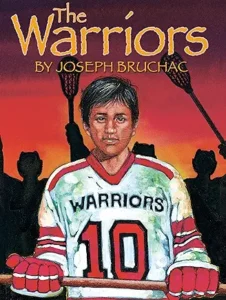
4. Beaver Steals Fire: A Salish Coyote Story told by the Confederated Salish and Kootenai Tribes, illustrated by Sam Sandoval
“This story represents thousands of years of oral tradition. In Beaver Steals Fire, fire is a gift from the Creator brought by the animal beings for human beings who are yet to come.” from Acknowledgements
“For those who use this book in the classroom, this story should be read or discussed only during winter when snow is on the ground. The elders usually bring out the stories in November and put them away again when the snow is gone. It is said that snakes will come to those who do not follow this custom or that cold weather will come during the warm months.” from A Note to the Reader
Since I do not want to disrespect the Salish and Kootenai traditions, and this is July, I am not reading the book as snow is not on the ground here in Boston and I certainly don’t wish for cold weather to come sooner than it already does. Please enjoy this book at the first snowfall. [picture book, ages 4 and up]
3. The Good Luck Cat by Joy Harjo
This is a modern Native American story from a member of the Muskogee-Creek tribe about Woogie, a cat that seems to be testing the notion of 9 lives. Will the good luck cat’s good luck run out? [picture book, ages 3 and up]
2. Soft Rain: A Story of the Cherokee Trail of Tears by Cornelia Cornelissen
In 1838, the Cherokee people were forced to relocate from North Carolina to the West. It is a long and dangerous journey and Cornelissen portrays this vividly through the eyes of Soft Rain, a nine-year-old girl. [middle grade, ages 8 and up]
1. Code Talker: A Novel about the Navajo Marines of World War Two by Joseph Bruchac
A gifted storyteller and a descendant of the Abenaki people, Joseph Bruchac is a prolific author of more than 70 books that reflect his heritage. Code Talkers is about the Navajo Marines, the unsung heroes, of World War II. The Navajos both developed an unbreakable code (all other codes were broken by the Japanese) and risked their lives in battle to transmit messages that used their native language. [young adult, ages 12 and up]
More Great Native American #OwnVoices Books
When the Stars Came Home by Brittany Luby, illustrated by Natasha Donovan
Review from A Kid’s Book A Day:
“A touching story about discovering what makes home, with indigenous stories and history woven into the contemporary text.” [picture book, ages 4 and up]
What Your Ribbon Skirt Means to Me: Deb Haaland’s Historic Inauguration by Alexis Bunten, illustrated by Nicole Neidhardt
Review by A Kid’s Book A Day:
“Details about Turtle Island indigenous culture (food, prayers, clothing) are woven into this story which also does a good job of introducing Secretary of the Interior Deb Haaland. I liked how the back matter encourages kids to take action.” [picture book, ages 4 and up]
Sharice’s Big Voice: A Native American Kid Becomes a Congresswoman by Sharice Davids with Nancy K. Mays, illustrated by Joshua Mangeshig Pawis-Steckley
Sharice Davids is the first LGBTQIA+ Native American elected to Congress, and the first of two Native Americans to become a congresswoman. While the reference to her sexuality is brief, “They thought I couldn’t win based on what I look like, who I love, and where I started,” her inspiring story recounts how she used her voice, her listening skills, and her hard work and determination to reach many goals including first to college in her family. Since becoming a congresswoman, Sharice has fought for legislation to support the mental health of at-risk LGBTQIA+ youth. [picture book biography, ages 4 and up]
Remember by Joy Harjo, illustrated by Michaela Goade
Review from A Kid’s Book A Day:
“Former U.S. Poet Laureate Joy Harjo’s poem celebrates life: the cosmos, the Earth, the plants and animals, and people, especially parents. “Remember you are the universe. And this universe is you. Remember.” Caldecott Medalist Michaela Goade’s illustrations depict a child traveling through the universe, with images inspired by traditions from her Tlingit culture. This beautiful book created by two Indigenous American artists celebrates the complexity of life and the universe, reminding the reader to stop and pay attention. A Caldecott contender for sure.” [picture book, ages 4 and up]
Berry Song by Michaela Goade
Michaela Goade shares the wisdom of her Tlingit people about caring for the land. A grandmother teaches her granddaughter how to harvest the gifts of the earth in this ode to foraging and respecting the gifts from Mother Earth. Set in The Tongass National Forest, this is the largest temperate rainforest in the world and is an example of how Indigenous peoples — Tlingit, Haida, and Tsimshian — work in harmony both with the earth and with each other. They set a beautiful example to follow in caring for our planet. [picture book, ages 4 and up]
Heart Berry Bling by Jenny Kay Dupuis, illustrated by Eva Campbell
Jenny Kay Dupuis brings First Nations stories to life, based on her grandmother’s experience, and told in an unflinching but compassionate way. In this story, Maggie, a young Ashihaiaabe girl, visits her grandmother and learns to bead. Her grandmother shows her that beading is also a metaphor for life. In her own life, the grandmother lost her First Nations status by marrying a non-Indigenous man. However, the law that took her status away did not affect a First Nations man. The gender discrimination built into this law was not corrected until 2011, and additional changes were also made in 2017 and 2019. Maggie perseveres with her beading and creates a beautiful pair of earrings, shaped like strawberries. Her grandmother tells her that this newer style of beadwork is called powwow bling. As she wears her earrings, Maggie is reminded of the beading lesson her grandmother taught her: truth, love, respect & trust, acceptance, peace, and hope. Jenny Kay Dupuis demonstrates that the power of storytelling is to teach, remember, learn, and grow. [picture book, ages 6 and up]
Tapwe and the Magic Hat by Buffy Sainte-Marie, illustrated by Buffy Sainte-Marie and Michelle Alynn Clement
When Tapwe visits his aunt and cousins, his grandmother gives him a magic hat with snakes and birds that stay on the hat because of an emotional bond. Tapwe enjoys the company of kids and meets, for the first time, the trickster rabbit, Wapos. At first, Tapwe is charmed by Wapos, then angry when Wapos steals his hat. Over time, Tapwe learns how valuable Wapos is because the trickster imparts wise life lessons. These charming gentle stories are modern folktales in the tradition of Indigenous stories by Cree author and songwriter Buffy Saint-Marie. [early chapter book, ages 6 and up]
We Are Still Here! Native American Truths Everyone Should Know by Traci Sorell, illustrated by Frane Lessac
Twelve Native American kids from different tribes present for Indigenous Peoples’ Day at school with truths that are relevant for our current times and also illuminating as we examine the history of the United States from a multicultural lens. [picture book, ages 7 and up]
The First Blade of Sweetgrass: A Native American Story by Suzanne Greenlaw and Gabriel Frey, illustrated by Nancy Baker
A grandmother gently passes down the knowledge of gathering sweetgrass for weaving baskets. Musqon, the granddaughter, struggles at first but then channels her connection to her ancestors. This Passamaquoddy and Maliseet story is also an environmental story of land conservation and preservation. [picture book, ages 6 and up]
A Peacemaker for Warring Nations: The Founding of the Iroquois League by Joseph Bruchac, illustrated by David Kanietakeron Fadden
The Peacemaker for Warring Nations feels like a story that is both spiritual and historical passed on through oral tradition about a man who comes from the Great Creator to bring peace to five warring nations. Those who study world religions might find similarities of the Peacemaker born to a mother without a father, to other religious leaders. This is a story that has inspired for centuries including Americans during the founding of our country. It is also a message that continues to be timely. [nonfiction biography and government, ages 10 and up]
Fry Bread by Kevin Noble Maillard, illustrated by Juana Martinez-Neal
Told in lively and powerful verse by debut author Kevin Noble Maillard, Fry Bread is an evocative depiction of a modern Native American family, vibrantly illustrated by Pura Belpre Award winner and Caldecott Honoree Juana Martinez-Neal.
Fry bread is food.
It is warm and delicious, piled high on a plate.
Fry bread is time.
It brings families together for meals and new memories.
Fry bread is nation.
It is shared by many, from coast to coast and beyond.
Fry bread is us.
It is a celebration of old and new, traditional and modern, similarities and differences. (from publisher) [picture book, ages 4 and up]
I Can Make This Promise by Christine Day
All her life, Edie has known that her mom was adopted by a white couple. So, no matter how curious she might be about her Native American heritage, Edie is sure her family doesn’t have any answers.
Until the day when she and her friends discover a box hidden in the attic—a box full of letters signed “Love, Edith,” and photos of a woman who looks just like her.
Suddenly, Edie has a flurry of new questions about this woman who shares her name. Could she belong to the Native family that Edie never knew about? But if her mom and dad have kept this secret from her all her life, how can she trust them to tell her the truth now? (from publisher)
Review from Ms. Yingling Reads:
“I always appreciate books that teach me something; I had no idea that Native American children were taken away from their parents in the 1970s and before. The Indian Child Welfare Act (https://www.nicwa.org/about-icwa/) was enacted in 1978, and yet I knew nothing about it. The family mystery is worked into the rest of Edie’s life well, and certainly, friend drama is a huge part of the middle-grade experience. My favorite part was when the parents finally told Edie about her heritage and finally gave her all of the details.” [middle grade, ages 8 and up]
At the Mountain’s Base by Traci Sorell, illustrated by Weshoyot Alvitre
A family, separated by duty and distance, waits for a loved one to return home in this lyrical picture book celebrating the bonds of a Cherokee family and the bravery of history-making women pilots.
At the mountain’s base sits a cabin under an old hickory tree. And in that cabin lives a family — loving, weaving, cooking, and singing. The strength in their song sustains them through trials on the ground and in the sky, as they wait for their loved one, a pilot, to return from war.
With an author’s note that pays homage to the true history of Native American U.S. service members like WWII pilot Ola Mildred “Millie” Rexroat, this is a story that reveals the roots that ground us, the dreams that help us soar, and the people and traditions that hold us up. (from publisher) [picture book, ages and up]
The Cloud Artist // Hoshonti Holvbttoba Inchunli: A Choctaw Tale by Sherri Maret, illustrated by Merisha Sequoia Clark
Leona is born with a special gift. She can tell stories by painting with clouds. It’s a gift that some want to exploit and soon Leona is performing at a carnival, but it does not make her happy. She returns home and uses her gift for stories that have meaning to her. And her gift, it seems, is passed on to other generations. This story was told to the author by her own Choctaw grandmother who also preserved stories. [bilingual English/Chocktaw picture book, ages 4 and up]
When A Ghost Talks Listen by Tim Tingle
It might not be widely known that the Choctaw were allies of the U.S. Government and that Choctaw Chief Pushmataha was also a U.S. Army General and close friend of Andrew Jackson. In this excellent series, the reader learns how Chief Pushmataha and other Choctaw chiefs were murdered by Andrew Jackson and his people, to remove them from their lands. [middle grade, ages 8 and up]
Stone River Crossing by Tim Tingle
Ms. Yingling Reads has a great review: “The story of enslaved people being aided by the people of the Choctaw Nation is one that I have not heard, and is an important one to tell. The friendships between Joseph, Martha, and Lil Mo underscore the point that children must learn prejudices, and are willing to make friends with anyone to whom they can connect, regardless of ethnicity, before they learn this. The Choctaw are exceedingly helpful to Lil Mo’s family, who are grateful and relieved to be in a safe environment. While the times in which these characters live are difficult, they show their best selves. While Bledsoe and Harold are unrepentantly evil, even Mr. Kendall and Mr. Porter are shown to have more sympathy for enslaved people than most others at this point in history.
There is a huge need for more middle-grade novels about Native Americans, both historical and modern-day, and I hope that this book will be added to the AICI list of “best books” along with Gansworth’s Give Me Some Truth, Dupuis’ I Am Not A Number, Erdrich’s Makoons, and Marshall’s In the Footsteps of Crazy Horse.” [middle grade, ages 8 and up]
Hedge Over Heels: A Wish Novel by Elise McMullen-Ciotti
Review by Ms. Yingling Reads:
“I’m a big fan of books where the main characters aren’t completely adverse to whatever is going on in their lives and have realistic struggles depicted. Rayna is fairly resigned; her plan to distance herself from others is based on a recent unpleasant friendship experience. She does warm up a bit to both her new environment and pet. She has a good support system, even if her mother is gone frequently, and I loved the depiction of the school and the neighborhood, even if I’ve never seen a school that decorates quite as extensively for holidays! Nick is a sweet first crush, and there’s a scene at the very end with the most minor hand-holding and a sweet kiss, which is perfect for a middle school romance. The author is Cherokee, so seeing a tiny bit of that culture in the portrayal of Nick is great.” [middle grade, ages 8 and up]
Mission To Space by John Herrington
John Herrington is the first enrolled member of a Native American tribe to fly in space, and he takes us with him as he prepares for his two weeks at the International Space Station. Infused with this experience is his Chickasaw heritage. He includes how the Chickasaw Nation supported his journey to space, and how he brought them along too symbolically through an eagle feather and flute that floated next to him onboard the space station. This is an important picture book that gives all children role models both in space travel and in the Native American community. This book was published by White Dog Press, an imprint under Chickasaw Press. Purchasing this book supports books that capture the experiences, culture, and history of Chickasaw. [picture book, ages 4 and up]
Saltypie: A Choctaw Journey from Darkness into Light by Tim Tingle, illustrated by Karen Clarkson
Debbie Reese of American Indians in Children’s Literature (AICL) blog has stressed the importance of showing contemporary Native Americans because kids seem to think that Native Americans do not exist now. I can see that misconception — it’s similar to our 2nd-grade unit in Ghana where kids think everyone lives in a rural village and that cities don’t exist in Africa.
Tim Tingle is an excellent children’s book author that I encourage everyone to check out. His picture book covers a multitude of Common Core and elementary school topics including bullying, immigration, Civil Rights, and contemporary Indian Americans.
Tim’s grandmother, a member of the Choctaw Nation, moves from Oklahoma to Texas as a young mother where she is greeted while standing on her front porch with a rock thrown to her head. It cuts her eye which leads eventually to her losing her vision. Tim’s father is two years old at the time.
While there is certainly anger and a desire for revenge, his grandmother redirects this energy with “Saltypie”, a term that means “bad things happen; let it go.” Many years later, his grandmother undergoes successful eye transplant surgery but the blessing she taught those around her is to see without eyes. [advanced picture book, ages 6 and up]
A Day With Yayah by Nicola I. Campbell, illustrated by Julie Flett
A lovely contemporary story of a multigenerational First Nations family as they spend time in Nicola Valley in British Columbia. The grandmother passes down her knowledge of the plant world as they collect herbs and mushrooms. [picture book, ages 4 and up]
I Am Not A Number by Jenny Kay Dupuis and Kay Kacer, illustrated by Gillian Newland
This is Jenny Kay Dupuis’ grandmother’s true story of the abuse she faced when she, along with all First Nations children, were forced to move to residential schools. This happened in both the United States and Canada. [picture book, ages 7 and up]
Crazy Horse’s Vision by Joseph Bruchac
Curly, as Crazy Horse was known as a young boy due to his curly hair, is portrayed in this picture book by Bruchac as a leader even as a young man. He became both a great leader for the Lakota people (also known as Sioux) and one of the most famous Native Americans in history. [picture book, ages 5 and up].
Thunder Boy Jr. by Sherman Alexie, illustrated by Yuyi Morales
*Sherman Alexie has been accused of sexual misconduct.
Sherman Alexie’s first picture book reflects on his Spokane Native American tradition of getting a new name to mark the transition to adulthood. There are 500 federally recognized tribal nations in the United States, each with its own diversity of language, ceremonies, and naming. To respect the deeper meaning of the naming, classroom activities where kids pick their own Indian names are not recommended as it is not culturally sensitive. This is a delightful picture book sure to engage kids. The vibrant illustrations by Caldecott illustrator Yuyi Morales perfectly match the story. [picture book, ages 4 and up]
Books for kids to learn about Thanksgiving recommended by Debbie Reese of American Indians in Children’s Literature: Margaret Bruchac’s photo essay 1621: A New Look at Thanksgiving.
Debbie also recommends reading Guests by Michael Dorris in tandem.
Here’s a review to get a sense of the plot from Amazon:
“When Moss, a young Algonquian boy, accidentally broke his grandfather’s wampum on the morning that he was already dreading enough; his bad luck just got worse. When he showed the broken wampum to his grandfather, his grandfather said that he would just have to replace the old story with his own story and use the wampum’s beads to tell the story. He was to finish the story before the guests came that evening. When Moss refused to help with the preparations, he told his parents that he would run away before he ate with them. Moss left the village while he followed another Native American girl named Trouble. He followed her into the woods, even though she asked him not to. When Moss first told her that he was going on his away time, she did not believe him. Even though he was lying, she was persuaded when he adventured into the forest by himself. He found an animal in the forest that helped him dig deep into his heart and pull out the real Moss. When he found that he was lost, he became discouraged and walked in one direction. He came upon Trouble who showed him the way back. Moss is unhappy that the guests were coming and thought he might not return to the village. I recommend this book to children from ages 8-12 who enjoy exciting stories.”
Eagle Song by Joseph Bruchac
I discovered Joseph Bruchac today at the library thanks to my “go-to” library in the Children’s Room. When I told her I was having trouble finding stories about the experience of Native Americans (versus nonfiction about their customs), she told me about Joseph Bruchac who is a talented and prolific writer of over 70 books both chapter and picture that reflect his Abenaki Native American culture. This is a great story about a contemporary boy struggling to straddle two cultures, American and Mohawk. It’s also a perfect level for a reluctant boy reader. [chapter book, ages 6 and up]
Little Bird’s Day by Sally Morgan, illustrated by Johnny Warrkatja Malibirr
Indigenous Peoples’ Day is not complete without Australian Aboriginal voices and this #OwnVoices book celebrates the life of Little Bird. Illustrations by Johnny Warrkatja Malibirr, a Yolnu man from the Aboriginal Ganalbingu clan, evoke the spirits and voices of Aboriginal ancestors. [picture book, ages 4 and up]
As I Enfold You in Petals (The Spirit of Denedeh, Vol. 2) by Richard Van Camp and Scott B. Henderson, illustrated by Donoval Vaciuk
Curtis has returned to Fort Smith, newly sober and motivated to save his town. His grandfather had the help of the Little People who healed the sick but they vanished when he died. Curtis offers, Benny the Bootlegger, a gift in return for his grandfather’s house and hopes to get the Little People to return so he can rebuild hope in his community. This graphic novel references Inuit culture through the traditional tattoos featured on the characters. [young adult graphic novel, ages 12 and up]
Native American Books that are NOT #OwnVoices for Kids Honorable Mentions
Dreamcatcher by Audrey Osofsky
A sweet picture book depicting the Ojibway Indians of the Great Lakes and their traditions including warding off bad dreams using dreamcatchers created from nettle-stalk twine stained dark red with the bark of wild plum. [picture book, ages 2 and up]
The Unbreakable Code by Sara Hoagland Hunter, illustrated by Julia Miner
I used The Unbreakable Code for a Book Club for Boys which made for a fun scavenger hunt solving clues in code. It’s the true story of the Navajo code talkers who are credited with turning the tide for the United States during WWII. The original code they used as well as Navajo words are in the back pages as well. [picture book, ages 6 and up]
Undefeated: Jim Thorpe and the Carlisle Indian School Football Team by Steve Sheinkin
Sheinkin is a master storyteller, reminiscent of a Pulitzer Prize-winning journalist though I don’t he was. He weaves the backstory to the Indian Boarding Schools including the underlying racist history behind it seamlessly into a page-turner of Jim Thorpe, Pop Warner, and the rise of football in which the Carlisle Indian School was its most unlikely team to succeed. But succeed it did, going on to a season in which they would best the Ivy Leagues, then the most competitive in this new sport. Sheinkin doesn’t shy away from calling out bigotry or exploitation, especially in telling a simultaneous backstory of Pop Warner which leaves a complicated legacy.
In some ways, this is the rise and fall of superathlete Jim Thorpe. Had he been born at different times, the outcome would be very different. In more modern times, he would be sitting on a multi-million dollar contract in football. Instead, Jim Thorpe’s future is constrained by racism, despite being quite possibly the best athlete of his generation. For non-football fans like myself, this is a page-turner fascinating read. For those who like history or football, it’s a must-read. Sheinkin’s meticulous research comes through, building a compelling story that feels very pertinent today even though it’s our history. [nonfiction historical fiction, ages 10 and up]
Photograph from Rhode Island School of Design Museum
p.s. Related posts:
#OwnVoices Powwow Picture Books
A Selection of #OwnVoices Native American Stories
Native American Residential Schools #OwnVoices Book List
Native American Folklore & Creation Stories by Native Americans
Top 10: Best Native American Books for Kids
Native American Book Lists For Kids
Books for Kids to Celebrate Native American Heritage Month
Plimoth Plantation: Learning About Native Americans
Contemporary Native Americans in KidLit
Native American Picture Book of the Day Exploration
Top 10: Best Native American Middle School Books
Top 10: Best Native American Young Adult Books
To examine any book more closely at Amazon, please click on image of book.
As an Amazon and IndieBound Associate, I earn from qualifying purchases.
Follow PragmaticMom’s board Multicultural Books for Kids on Pinterest.
Follow PragmaticMom’s board Children’s Book Activities on Pinterest.
My books:
Food for the Future: Sustainable Farms Around the World
- Junior Library Guild Gold selection
- Selected as one of 100 Outstanding Picture Books of 2023 by dPICTUS and featured at the Bologna Children’s Book Fair
- Starred review from School Library Journal
- Chicago Library’s Best of the Best
- Imagination Soup’s 35 Best Nonfiction Books of 2023 for Kids
Amazon / Barefoot Books / Signed or Inscribed by Me



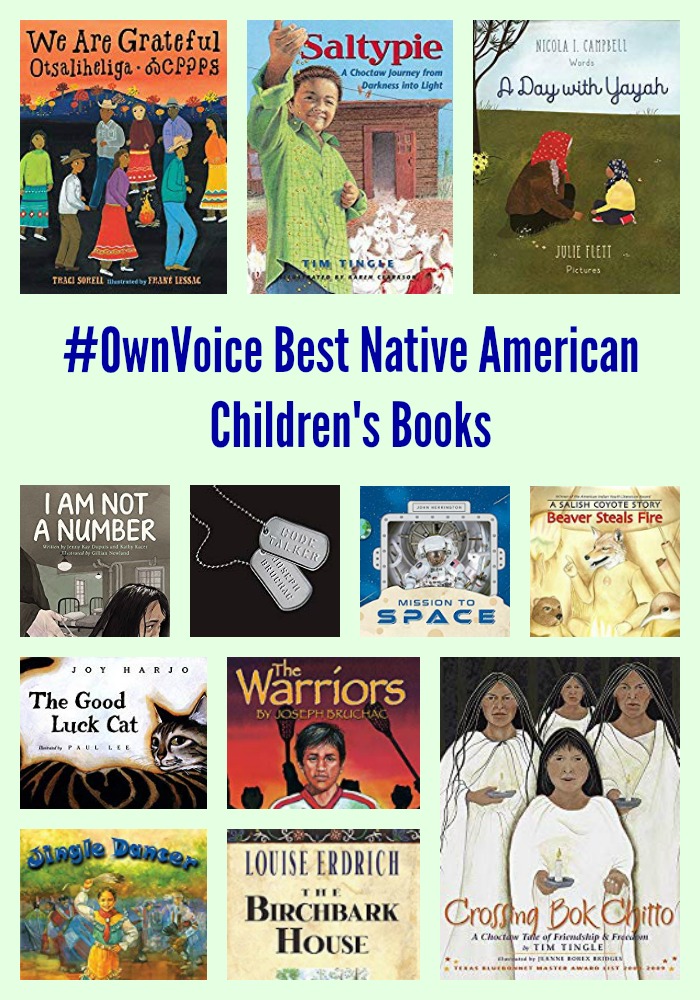


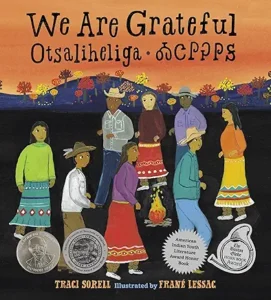








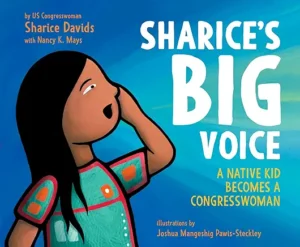

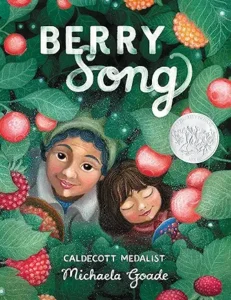



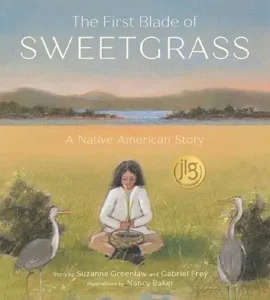
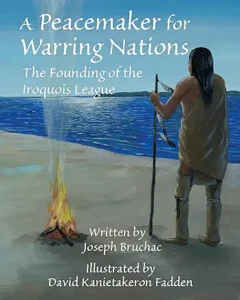









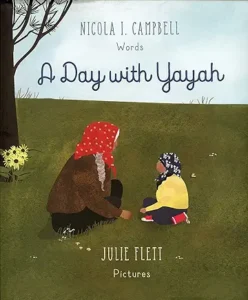




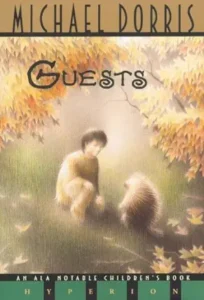
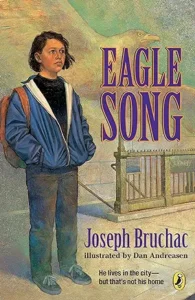



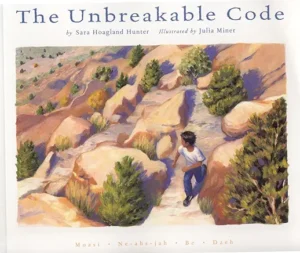
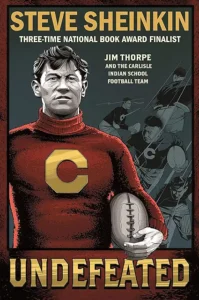

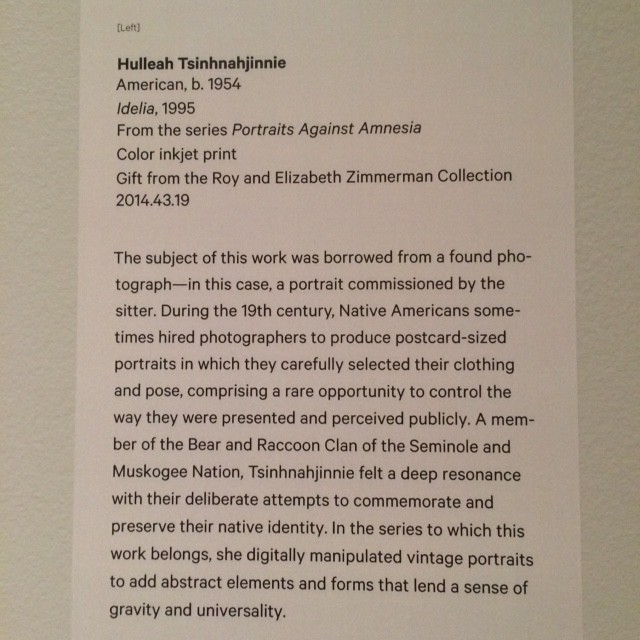
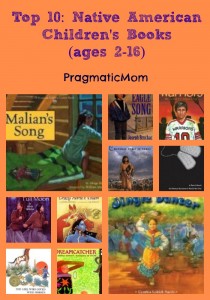


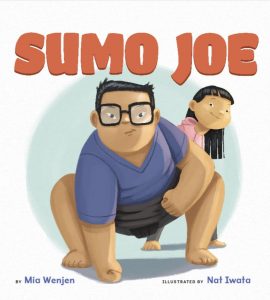







We also like music, and the children play our piano also the guitar and tin whistle. History Wholesale
Good morning,
I am Pueblo Indian, a former schoolteacher, currently a professor in American Indian Studies, and, I study children’s books. I’ve been publishing a blog/resource called American Indians in Children’s Literature for about five years. I invite you and your readers to visit the site. There, I talk about popular, classic, best-selling books, and lesson plans, and movies, and… anything that in some way informs how Americans think about (and portray) American Indians…
Marge’s book is terrific, as are Joe’s (they’re brother/sister). I think his HIDDEN ROOTS is one of his best books. You’ve got Goble on your list, and Gloria Whelan, too, neither of which I recommend.
I’ve written for Horn Book, and School Library Journal, too. Please do visit my site.
–Debbie
What a great resource you are. Thank you! I have added your blog to my blog roll for children’s literature. I will check out Hidden Roots. Thanks also for your comment. This is my first foray into Native American Children’s Literature and it’s been a great learning experience for me.
I am hoping that Debbie Reese will agree to create a Top 10 list for me on the American Indian Children’s Books she likes.
Being one of the few reviewers of books with Native American themes, I’d like to lead you to a new English/Cherokee picture book. SPEARFINGER has been declared the #1 New Release in Children’s American Folk Tales and Myths category.
Thanks Aidana,
I’m buying a copy of Spearfinger right now. There are not enough of these kinds of books out there. Is the author/illustrator #ownvoices?
Awesome 🙂
After leaving my comment, I discovered there are a few books on Amazon titled SPEARFINGER in publication and I didn’t want to confuse you. The one I am referring to is by Charles Suddeth (illustrated by Carrie Salazar). I hope you enjoy it. 🙂
Hi Aidana,
Thanks for the heads up! I just bought it and posted on it on ReadYourWorldMCBD Instagram. I’m going to do a Native American Folk Tales post with books by #ownvoices and will include it. What others do you recommend?
I am aware of another #ownvoices tale through the same publisher, but it’s in English/Spanish rather than English/Cherokee. Would you be interested in reviewing that, too?
I do know there are more bilingual books in production at 4RV Publishing right now, but I don’t have a strict timeline as to when they’ll be available. Email me directly if you don’t want all of this in your comments.
Yes! I’d love to read it. Let me know the title and I’ll buy a copy when it is out. Thanks so much Aidana!
Awesome 🙂 You are quickly becoming my favorite children’s book reviewer. 🙂
The title is: Rey Antonio & Rey Feo. Here’s the publisher’s link to the book, where it’s available at a discounted price:
www (dot) 4rvpublishingcatalog (dot) com/kena-sosa (dot) php
Thanks so much Aidana! 🙂
I read the comment by Aidana WillowRaven and you replied with a phrase author/illustrator # ownvoices. Could you tell me what that means?
Hi Vivian,
#OwnVoices means that the person is a person of color writing about his/her culture, as opposed to an outsider.
Hello,
I am looking for a book called “Echogee”, by Ace Blue Eagle. Have searched everywhere. Would love to buy a copy.
Please let me know if you can find it.
Thank you,
You might be able to buy it on ebay: https://www.ebay.com/itm/Echogee-The-Little-Blue-Deer-Acee-Blue-Eagle-2nd-Edition-/292459670769
It looks like it is out of print and sold out everywhere! 🙁
I would like to introduce a new book: Tale of the Turkeys’ Detailed Tale
Come along on this fun story written by a member of the Nanticoke Lenni-Lenape Indian Tribe that tells about a journey of a famous turkey and how he introduced many tribes to each other. This is a great story that tells a tale about Native American Indians before the Europeans came to America. Native American stories are always told to the children, not only keep history, but it allows them to use their great imagination about subjects that have deep hidden meanings of the way things really are. This story is great for all ages! The main character of this story is Chikënëm. This is the Lenape word for Turkey. You can also say “chicken” for a shorter version. I would like to think that this is why we call the modern-day bird that we eat a chicken!
I appreciate your list. I did notice, in looking up Night of the Full Moon, it is NOT written by a native author, and that is listed as *not recommended* on Debbie Reese’s site. She writes:
“In Night of the Full Moon, Whelan tried to do some things right, but couldn’t break out of stereotypical tropes that characterize far too many stories about American Indians. And because those stereotypes are so predominant and *not* recognized as problematic, the book was listed on a few “best books” lists when it came out.”
Here’s the link for her review of it.
https://americanindiansinchildrensliterature.blogspot.com/2012/06/night-of-full-moon-by-gloria-whelan.html
Thanks so much Camille! I will update my list and remove that book.